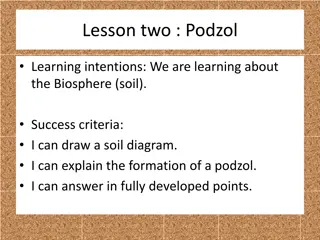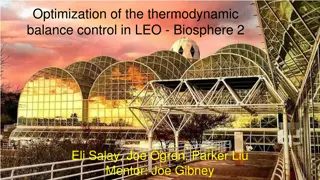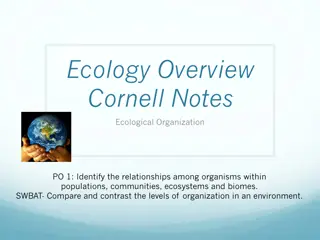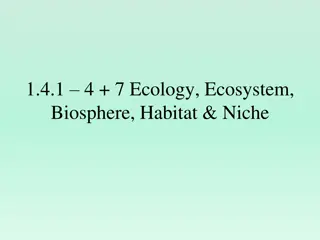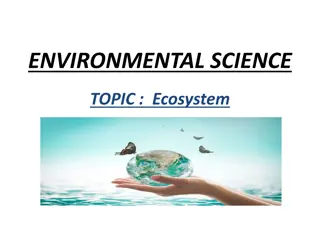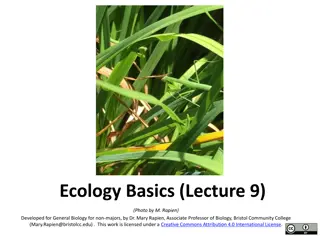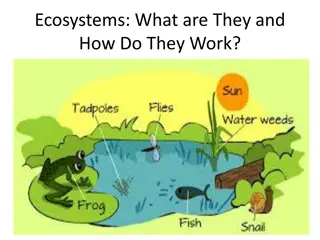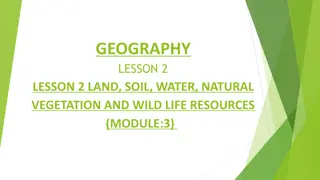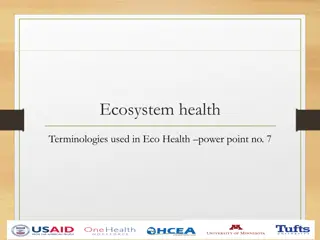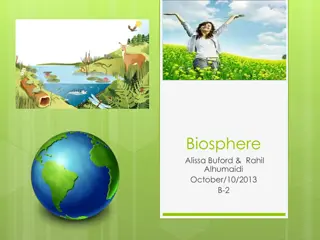Understanding Ecosystems and Biosphere
Explore the concepts of ecosystems, biosphere, and habitats in this interactive quiz. Learn about living organisms, environmental factors, energy flow, and more that contribute to the intricate balance of nature.
Download Presentation

Please find below an Image/Link to download the presentation.
The content on the website is provided AS IS for your information and personal use only. It may not be sold, licensed, or shared on other websites without obtaining consent from the author. Download presentation by click this link. If you encounter any issues during the download, it is possible that the publisher has removed the file from their server.
E N D
Presentation Transcript
1.4.2 Ecosystem 1.4.3 Biosphere 1.4.4 Habitat 1.4.5 Environmental Factors 1.4.6 Energy Flow Follow-Me iQuiz
Q. Explain the term biosphere. A community of living organisms interacting with one another and their environment Producers; Autotrophs A community of living organisms interacting with one another and their environment Producers; Autotrophs No. They are not producers No. They are not producers Climatic; Edaphic; etc. Relating to the soil Climatic; Edaphic; etc. Relating to the soil Non-living features that influence the distribution of organisms Non-living features that influence the distribution of organisms FALSE The numbers of organisms at each trophic level The numbers of organisms at each trophic level FALSE Particle size; Soil type; pH; Air content; Water content; Mineral content; Humus content Particle size; Soil type; pH; Air content; Water content; Mineral content; Humus content The part of the planet where life occurs First level The part of the planet where life occurs First level Photosynthesis Photosynthesis The place where an organism lives Heat The place where an organism lives Heat Predator (fox) influences distribution of rabbits Predator (fox) influences distribution of rabbits Interconnected food chains; More than one species at each trophic level The position of an organism in a food chain Interconnected food chains; More than one species at each trophic level The position of an organism in a food chain Primary consumer(s); Herbivore(s) Primary consumer(s); Herbivore(s) Large energy loss from one level to next; Small energy transfer The sun Large energy loss from one level to next; Small energy transfer The sun Producers are large; Primary consumers are parasites Producers are large; Primary consumers are parasites Living features that influence the distribution of organisms TRUE Living features that influence the distribution of organisms TRUE
CONGRATULATIONS Please CLICK on THIS BOX for the Next Question Please CLICK on THIS BOX for the Next Question
Q. What is an ecosystem? A community of living organisms interacting with one another and their environment Producers; Autotrophs A community of living organisms interacting with one another and their environment Producers; Autotrophs No. They are not producers No. They are not producers Climatic; Edaphic; etc. Relating to the soil Climatic; Edaphic; etc. Relating to the soil Non-living features that influence the distribution of organisms Non-living features that influence the distribution of organisms FALSE The numbers of organisms at each trophic level The numbers of organisms at each trophic level FALSE Particle size; Soil type; pH; Air content; Water content; Mineral content; Humus content Particle size; Soil type; pH; Air content; Water content; Mineral content; Humus content The part of the planet where life occurs First level The part of the planet where life occurs First level Photosynthesis Photosynthesis The place where an organism lives Heat The place where an organism lives Heat Predator (fox) influences distribution of rabbits Predator (fox) influences distribution of rabbits Interconnected food chains; More than one species at each trophic level The position of an organism in a food chain Interconnected food chains; More than one species at each trophic level The position of an organism in a food chain Primary consumer(s); Herbivore(s) Primary consumer(s); Herbivore(s) Large energy loss from one level to next; Small energy transfer The sun Large energy loss from one level to next; Small energy transfer The sun Producers are large; Primary consumers are parasites Producers are large; Primary consumers are parasites Living features that influence the distribution of organisms TRUE Living features that influence the distribution of organisms TRUE
CONGRATULATIONS Please CLICK on THIS BOX for the Next Question Please CLICK on THIS BOX for the Next Question
Q. What is a habitat? A community of living organisms interacting with one another and their environment Producers; Autotrophs A community of living organisms interacting with one another and their environment Producers; Autotrophs No. They are not producers No. They are not producers Climatic; Edaphic; etc. Relating to the soil Climatic; Edaphic; etc. Relating to the soil Non-living features that influence the distribution of organisms Non-living features that influence the distribution of organisms FALSE The numbers of organisms at each trophic level The numbers of organisms at each trophic level FALSE Particle size; Soil type; pH; Air content; Water content; Mineral content; Humus content Particle size; Soil type; pH; Air content; Water content; Mineral content; Humus content The part of the planet where life occurs First level The part of the planet where life occurs First level Photosynthesis Photosynthesis The place where an organism lives Heat The place where an organism lives Heat Predator (fox) influences distribution of rabbits Predator (fox) influences distribution of rabbits Interconnected food chains; More than one species at each trophic level The position of an organism in a food chain Interconnected food chains; More than one species at each trophic level The position of an organism in a food chain Primary consumer(s); Herbivore(s) Primary consumer(s); Herbivore(s) Large energy loss from one level to next; Small energy transfer The sun Large energy loss from one level to next; Small energy transfer The sun Producers are large; Primary consumers are parasites Producers are large; Primary consumers are parasites Living features that influence the distribution of organisms TRUE Living features that influence the distribution of organisms TRUE
CONGRATULATIONS Please CLICK on THIS BOX for the Next Question Please CLICK on THIS BOX for the Next Question
Q. In ecological studies what are abiotic factors. A community of living organisms interacting with one another and their environment Producers; Autotrophs A community of living organisms interacting with one another and their environment Producers; Autotrophs No. They are not producers No. They are not producers Climatic; Edaphic; etc. Relating to the soil Climatic; Edaphic; etc. Relating to the soil Non-living features that influence the distribution of organisms Non-living features that influence the distribution of organisms FALSE The numbers of organisms at each trophic level The numbers of organisms at each trophic level FALSE Particle size; Soil type; pH; Air content; Water content; Mineral content; Humus content Particle size; Soil type; pH; Air content; Water content; Mineral content; Humus content The part of the planet where life occurs First level The part of the planet where life occurs First level Photosynthesis Photosynthesis The place where an organism lives Heat The place where an organism lives Heat Predator (fox) influences distribution of rabbits Predator (fox) influences distribution of rabbits Interconnected food chains; More than one species at each trophic level The position of an organism in a food chain Interconnected food chains; More than one species at each trophic level The position of an organism in a food chain Primary consumer(s); Herbivore(s) Primary consumer(s); Herbivore(s) Large energy loss from one level to next; Small energy transfer The sun Large energy loss from one level to next; Small energy transfer The sun Producers are large; Primary consumers are parasites Producers are large; Primary consumers are parasites Living features that influence the distribution of organisms TRUE Living features that influence the distribution of organisms TRUE
CONGRATULATIONS Please CLICK on THIS BOX for the Next Question Please CLICK on THIS BOX for the Next Question
Q. Explain the term edaphic. A community of living organisms interacting with one another and their environment Producers; Autotrophs A community of living organisms interacting with one another and their environment Producers; Autotrophs No. They are not producers No. They are not producers Climatic; Edaphic; etc. Relating to the soil Climatic; Edaphic; etc. Relating to the soil Non-living features that influence the distribution of organisms Non-living features that influence the distribution of organisms FALSE The numbers of organisms at each trophic level The numbers of organisms at each trophic level FALSE Particle size; Soil type; pH; Air content; Water content; Mineral content; Humus content Particle size; Soil type; pH; Air content; Water content; Mineral content; Humus content The part of the planet where life occurs First level The part of the planet where life occurs First level Photosynthesis Photosynthesis The place where an organism lives Heat The place where an organism lives Heat Predator (fox) influences distribution of rabbits Predator (fox) influences distribution of rabbits Interconnected food chains; More than one species at each trophic level The position of an organism in a food chain Interconnected food chains; More than one species at each trophic level The position of an organism in a food chain Primary consumer(s); Herbivore(s) Primary consumer(s); Herbivore(s) Large energy loss from one level to next; Small energy transfer The sun Large energy loss from one level to next; Small energy transfer The sun Producers are large; Primary consumers are parasites Producers are large; Primary consumers are parasites Living features that influence the distribution of organisms TRUE Living features that influence the distribution of organisms TRUE
CONGRATULATIONS Please CLICK on THIS BOX for the Next Question Please CLICK on THIS BOX for the Next Question
Q. True or False. The term abiotic refers to the living factors in an ecosystem. A community of living organisms interacting with one another and their environment Producers; Autotrophs A community of living organisms interacting with one another and their environment Producers; Autotrophs No. They are not producers No. They are not producers Climatic; Edaphic; etc. Relating to the soil Climatic; Edaphic; etc. Relating to the soil Non-living features that influence the distribution of organisms Non-living features that influence the distribution of organisms FALSE The numbers of organisms at each trophic level The numbers of organisms at each trophic level FALSE Particle size; Soil type; pH; Air content; Water content; Mineral content; Humus content Particle size; Soil type; pH; Air content; Water content; Mineral content; Humus content The part of the planet where life occurs First level The part of the planet where life occurs First level Photosynthesis Photosynthesis The place where an organism lives Heat The place where an organism lives Heat Predator (fox) influences distribution of rabbits Predator (fox) influences distribution of rabbits Interconnected food chains; More than one species at each trophic level The position of an organism in a food chain Interconnected food chains; More than one species at each trophic level The position of an organism in a food chain Primary consumer(s); Herbivore(s) Primary consumer(s); Herbivore(s) Large energy loss from one level to next; Small energy transfer The sun Large energy loss from one level to next; Small energy transfer The sun Producers are large; Primary consumers are parasites Producers are large; Primary consumers are parasites Living features that influence the distribution of organisms TRUE Living features that influence the distribution of organisms TRUE
CONGRATULATIONS Please CLICK on THIS BOX for the Next Question Please CLICK on THIS BOX for the Next Question
Q. Give an example of an abiotic factor that influences the distribution of a named plant in an ecosystem. A community of living organisms interacting with one another and their environment Producers; Autotrophs A community of living organisms interacting with one another and their environment Producers; Autotrophs No. They are not producers No. They are not producers Climatic; Edaphic; etc. Relating to the soil Climatic; Edaphic; etc. Relating to the soil Non-living features that influence the distribution of organisms Non-living features that influence the distribution of organisms FALSE The numbers of organisms at each trophic level The numbers of organisms at each trophic level FALSE Particle size; Soil type; pH; Air content; Water content; Mineral content; Humus content Particle size; Soil type; pH; Air content; Water content; Mineral content; Humus content The part of the planet where life occurs First level The part of the planet where life occurs First level Photosynthesis Photosynthesis The place where an organism lives Heat The place where an organism lives Heat Predator (fox) influences distribution of rabbits Predator (fox) influences distribution of rabbits Interconnected food chains; More than one species at each trophic level The position of an organism in a food chain Interconnected food chains; More than one species at each trophic level The position of an organism in a food chain Primary consumer(s); Herbivore(s) Primary consumer(s); Herbivore(s) Large energy loss from one level to next; Small energy transfer The sun Large energy loss from one level to next; Small energy transfer The sun Producers are large; Primary consumers are parasites Producers are large; Primary consumers are parasites Living features that influence the distribution of organisms TRUE Living features that influence the distribution of organisms TRUE
CONGRATULATIONS Please CLICK on THIS BOX for the Next Question Please CLICK on THIS BOX for the Next Question
Q. Give an example of an edaphic factor. A community of living organisms interacting with one another and their environment Producers; Autotrophs A community of living organisms interacting with one another and their environment Producers; Autotrophs No. They are not producers No. They are not producers Climatic; Edaphic; etc. Relating to the soil Climatic; Edaphic; etc. Relating to the soil Non-living features that influence the distribution of organisms Non-living features that influence the distribution of organisms FALSE The numbers of organisms at each trophic level The numbers of organisms at each trophic level FALSE Particle size; Soil type; pH; Air content; Water content; Mineral content; Humus content Particle size; Soil type; pH; Air content; Water content; Mineral content; Humus content The part of the planet where life occurs First level The part of the planet where life occurs First level Photosynthesis Photosynthesis The place where an organism lives Heat The place where an organism lives Heat Predator (fox) influences distribution of rabbits Predator (fox) influences distribution of rabbits Interconnected food chains; More than one species at each trophic level The position of an organism in a food chain Interconnected food chains; More than one species at each trophic level The position of an organism in a food chain Primary consumer(s); Herbivore(s) Primary consumer(s); Herbivore(s) Large energy loss from one level to next; Small energy transfer The sun Large energy loss from one level to next; Small energy transfer The sun Producers are large; Primary consumers are parasites Producers are large; Primary consumers are parasites Living features that influence the distribution of organisms TRUE Living features that influence the distribution of organisms TRUE
CONGRATULATIONS Please CLICK on THIS BOX for the Next Question Please CLICK on THIS BOX for the Next Question
Q. In ecological studies what are biotic factors. A community of living organisms interacting with one another and their environment Producers; Autotrophs A community of living organisms interacting with one another and their environment Producers; Autotrophs No. They are not producers No. They are not producers Climatic; Edaphic; etc. Relating to the soil Climatic; Edaphic; etc. Relating to the soil Non-living features that influence the distribution of organisms Non-living features that influence the distribution of organisms FALSE The numbers of organisms at each trophic level The numbers of organisms at each trophic level FALSE Particle size; Soil type; pH; Air content; Water content; Mineral content; Humus content Particle size; Soil type; pH; Air content; Water content; Mineral content; Humus content The part of the planet where life occurs First level The part of the planet where life occurs First level Photosynthesis Photosynthesis The place where an organism lives Heat The place where an organism lives Heat Predator (fox) influences distribution of rabbits Predator (fox) influences distribution of rabbits Interconnected food chains; More than one species at each trophic level The position of an organism in a food chain Interconnected food chains; More than one species at each trophic level The position of an organism in a food chain Primary consumer(s); Herbivore(s) Primary consumer(s); Herbivore(s) Large energy loss from one level to next; Small energy transfer The sun Large energy loss from one level to next; Small energy transfer The sun Producers are large; Primary consumers are parasites Producers are large; Primary consumers are parasites Living features that influence the distribution of organisms TRUE Living features that influence the distribution of organisms TRUE
CONGRATULATIONS Please CLICK on THIS BOX for the Next Question Please CLICK on THIS BOX for the Next Question
Q. What is meant by a pyramid of numbers? A community of living organisms interacting with one another and their environment Producers; Autotrophs A community of living organisms interacting with one another and their environment Producers; Autotrophs No. They are not producers No. They are not producers Climatic; Edaphic; etc. Relating to the soil Climatic; Edaphic; etc. Relating to the soil Non-living features that influence the distribution of organisms Non-living features that influence the distribution of organisms FALSE The numbers of organisms at each trophic level The numbers of organisms at each trophic level FALSE Particle size; Soil type; pH; Air content; Water content; Mineral content; Humus content Particle size; Soil type; pH; Air content; Water content; Mineral content; Humus content The part of the planet where life occurs First level The part of the planet where life occurs First level Photosynthesis Photosynthesis The place where an organism lives Heat The place where an organism lives Heat Predator (fox) influences distribution of rabbits Predator (fox) influences distribution of rabbits Interconnected food chains; More than one species at each trophic level The position of an organism in a food chain Interconnected food chains; More than one species at each trophic level The position of an organism in a food chain Primary consumer(s); Herbivore(s) Primary consumer(s); Herbivore(s) Large energy loss from one level to next; Small energy transfer The sun Large energy loss from one level to next; Small energy transfer The sun Producers are large; Primary consumers are parasites Producers are large; Primary consumers are parasites Living features that influence the distribution of organisms TRUE Living features that influence the distribution of organisms TRUE
CONGRATULATIONS Please CLICK on THIS BOX for the Next Question Please CLICK on THIS BOX for the Next Question
Q. Give an example of a biotic factor that influences the distribution of a named animal. A community of living organisms interacting with one another and their environment Producers; Autotrophs A community of living organisms interacting with one another and their environment Producers; Autotrophs No. They are not producers No. They are not producers Climatic; Edaphic; etc. Relating to the soil Climatic; Edaphic; etc. Relating to the soil Non-living features that influence the distribution of organisms Non-living features that influence the distribution of organisms FALSE The numbers of organisms at each trophic level The numbers of organisms at each trophic level FALSE Particle size; Soil type; pH; Air content; Water content; Mineral content; Humus content Particle size; Soil type; pH; Air content; Water content; Mineral content; Humus content The part of the planet where life occurs First level The part of the planet where life occurs First level Photosynthesis Photosynthesis The place where an organism lives Heat The place where an organism lives Heat Predator (fox) influences distribution of rabbits Predator (fox) influences distribution of rabbits Interconnected food chains; More than one species at each trophic level The position of an organism in a food chain Interconnected food chains; More than one species at each trophic level The position of an organism in a food chain Primary consumer(s); Herbivore(s) Primary consumer(s); Herbivore(s) Large energy loss from one level to next; Small energy transfer The sun Large energy loss from one level to next; Small energy transfer The sun Producers are large; Primary consumers are parasites Producers are large; Primary consumers are parasites Living features that influence the distribution of organisms TRUE Living features that influence the distribution of organisms TRUE
CONGRATULATIONS Please CLICK on THIS BOX for the Next Question Please CLICK on THIS BOX for the Next Question
Q. What term is used by ecologists to describe the organisms that form the base of a pyramid of numbers? A community of living organisms interacting with one another and their environment Producers; Autotrophs A community of living organisms interacting with one another and their environment Producers; Autotrophs No. They are not producers No. They are not producers Climatic; Edaphic; etc. Relating to the soil Climatic; Edaphic; etc. Relating to the soil Non-living features that influence the distribution of organisms Non-living features that influence the distribution of organisms FALSE The numbers of organisms at each trophic level The numbers of organisms at each trophic level FALSE Particle size; Soil type; pH; Air content; Water content; Mineral content; Humus content Particle size; Soil type; pH; Air content; Water content; Mineral content; Humus content The part of the planet where life occurs First level The part of the planet where life occurs First level Photosynthesis Photosynthesis The place where an organism lives Heat The place where an organism lives Heat Predator (fox) influences distribution of rabbits Predator (fox) influences distribution of rabbits Interconnected food chains; More than one species at each trophic level The position of an organism in a food chain Interconnected food chains; More than one species at each trophic level The position of an organism in a food chain Primary consumer(s); Herbivore(s) Primary consumer(s); Herbivore(s) Large energy loss from one level to next; Small energy transfer The sun Large energy loss from one level to next; Small energy transfer The sun Producers are large; Primary consumers are parasites Producers are large; Primary consumers are parasites Living features that influence the distribution of organisms TRUE Living features that influence the distribution of organisms TRUE
CONGRATULATIONS Please CLICK on THIS BOX for the Next Question Please CLICK on THIS BOX for the Next Question
Q. In ecology what is meant by a trophic level? A community of living organisms interacting with one another and their environment Producers; Autotrophs A community of living organisms interacting with one another and their environment Producers; Autotrophs No. They are not producers No. They are not producers Climatic; Edaphic; etc. Relating to the soil Climatic; Edaphic; etc. Relating to the soil Non-living features that influence the distribution of organisms Non-living features that influence the distribution of organisms FALSE The numbers of organisms at each trophic level The numbers of organisms at each trophic level FALSE Particle size; Soil type; pH; Air content; Water content; Mineral content; Humus content Particle size; Soil type; pH; Air content; Water content; Mineral content; Humus content The part of the planet where life occurs First level The part of the planet where life occurs First level Photosynthesis Photosynthesis The place where an organism lives Heat The place where an organism lives Heat Predator (fox) influences distribution of rabbits Predator (fox) influences distribution of rabbits Interconnected food chains; More than one species at each trophic level The position of an organism in a food chain Interconnected food chains; More than one species at each trophic level The position of an organism in a food chain Primary consumer(s); Herbivore(s) Primary consumer(s); Herbivore(s) Large energy loss from one level to next; Small energy transfer The sun Large energy loss from one level to next; Small energy transfer The sun Producers are large; Primary consumers are parasites Producers are large; Primary consumers are parasites Living features that influence the distribution of organisms TRUE Living features that influence the distribution of organisms TRUE
CONGRATULATIONS Please CLICK on THIS BOX for the Next Question Please CLICK on THIS BOX for the Next Question
Q. What is a food web? A community of living organisms interacting with one another and their environment Producers; Autotrophs A community of living organisms interacting with one another and their environment Producers; Autotrophs No. They are not producers No. They are not producers Climatic; Edaphic; etc. Relating to the soil Climatic; Edaphic; etc. Relating to the soil Non-living features that influence the distribution of organisms Non-living features that influence the distribution of organisms FALSE The numbers of organisms at each trophic level The numbers of organisms at each trophic level FALSE Particle size; Soil type; pH; Air content; Water content; Mineral content; Humus content Particle size; Soil type; pH; Air content; Water content; Mineral content; Humus content The part of the planet where life occurs First level The part of the planet where life occurs First level Photosynthesis Photosynthesis The place where an organism lives Heat The place where an organism lives Heat Predator (fox) influences distribution of rabbits Predator (fox) influences distribution of rabbits Interconnected food chains; More than one species at each trophic level The position of an organism in a food chain Interconnected food chains; More than one species at each trophic level The position of an organism in a food chain Primary consumer(s); Herbivore(s) Primary consumer(s); Herbivore(s) Large energy loss from one level to next; Small energy transfer The sun Large energy loss from one level to next; Small energy transfer The sun Producers are large; Primary consumers are parasites Producers are large; Primary consumers are parasites Living features that influence the distribution of organisms TRUE Living features that influence the distribution of organisms TRUE
CONGRATULATIONS Please CLICK on THIS BOX for the Next Question Please CLICK on THIS BOX for the Next Question
Q. True or False. Herbivores normally live long lives. A community of living organisms interacting with one another and their environment Producers; Autotrophs A community of living organisms interacting with one another and their environment Producers; Autotrophs No. They are not producers No. They are not producers Climatic; Edaphic; etc. Relating to the soil Climatic; Edaphic; etc. Relating to the soil Non-living features that influence the distribution of organisms Non-living features that influence the distribution of organisms FALSE The numbers of organisms at each trophic level The numbers of organisms at each trophic level FALSE Particle size; Soil type; pH; Air content; Water content; Mineral content; Humus content Particle size; Soil type; pH; Air content; Water content; Mineral content; Humus content The part of the planet where life occurs First level The part of the planet where life occurs First level Photosynthesis Photosynthesis The place where an organism lives Heat The place where an organism lives Heat Predator (fox) influences distribution of rabbits Predator (fox) influences distribution of rabbits Interconnected food chains; More than one species at each trophic level The position of an organism in a food chain Interconnected food chains; More than one species at each trophic level The position of an organism in a food chain Primary consumer(s); Herbivore(s) Primary consumer(s); Herbivore(s) Large energy loss from one level to next; Small energy transfer The sun Large energy loss from one level to next; Small energy transfer The sun Producers are large; Primary consumers are parasites Producers are large; Primary consumers are parasites Living features that influence the distribution of organisms TRUE Living features that influence the distribution of organisms TRUE
CONGRATULATIONS Please CLICK on THIS BOX for the Next Question Please CLICK on THIS BOX for the Next Question
Q. Organisms capable of making their own food are known as A community of living organisms interacting with one another and their environment Producers; Autotrophs A community of living organisms interacting with one another and their environment Producers; Autotrophs No. They are not producers No. They are not producers Climatic; Edaphic; etc. Relating to the soil Climatic; Edaphic; etc. Relating to the soil Non-living features that influence the distribution of organisms Non-living features that influence the distribution of organisms FALSE The numbers of organisms at each trophic level The numbers of organisms at each trophic level FALSE Particle size; Soil type; pH; Air content; Water content; Mineral content; Humus content Particle size; Soil type; pH; Air content; Water content; Mineral content; Humus content The part of the planet where life occurs First level The part of the planet where life occurs First level Photosynthesis Photosynthesis The place where an organism lives Heat The place where an organism lives Heat Predator (fox) influences distribution of rabbits Predator (fox) influences distribution of rabbits Interconnected food chains; More than one species at each trophic level The position of an organism in a food chain Interconnected food chains; More than one species at each trophic level The position of an organism in a food chain Primary consumer(s); Herbivore(s) Primary consumer(s); Herbivore(s) Large energy loss from one level to next; Small energy transfer The sun Large energy loss from one level to next; Small energy transfer The sun Producers are large; Primary consumers are parasites Producers are large; Primary consumers are parasites Living features that influence the distribution of organisms TRUE Living features that influence the distribution of organisms TRUE
CONGRATULATIONS Please CLICK on THIS BOX for the Next Question Please CLICK on THIS BOX for the Next Question
Q. Where in a food chain are primary producers found? A community of living organisms interacting with one another and their environment Producers; Autotrophs A community of living organisms interacting with one another and their environment Producers; Autotrophs No. They are not producers No. They are not producers Climatic; Edaphic; etc. Relating to the soil Climatic; Edaphic; etc. Relating to the soil Non-living features that influence the distribution of organisms Non-living features that influence the distribution of organisms FALSE The numbers of organisms at each trophic level The numbers of organisms at each trophic level FALSE Particle size; Soil type; pH; Air content; Water content; Mineral content; Humus content Particle size; Soil type; pH; Air content; Water content; Mineral content; Humus content The part of the planet where life occurs First level The part of the planet where life occurs First level Photosynthesis Photosynthesis The place where an organism lives Heat The place where an organism lives Heat Predator (fox) influences distribution of rabbits Predator (fox) influences distribution of rabbits Interconnected food chains; More than one species at each trophic level The position of an organism in a food chain Interconnected food chains; More than one species at each trophic level The position of an organism in a food chain Primary consumer(s); Herbivore(s) Primary consumer(s); Herbivore(s) Large energy loss from one level to next; Small energy transfer The sun Large energy loss from one level to next; Small energy transfer The sun Producers are large; Primary consumers are parasites Producers are large; Primary consumers are parasites Living features that influence the distribution of organisms TRUE Living features that influence the distribution of organisms TRUE
CONGRATULATIONS Please CLICK on THIS BOX for the Next Question Please CLICK on THIS BOX for the Next Question
Q. Why are most food chains short i.e. only consist of a few trophic levels? A community of living organisms interacting with one another and their environment Producers; Autotrophs A community of living organisms interacting with one another and their environment Producers; Autotrophs No. They are not producers No. They are not producers Climatic; Edaphic; etc. Relating to the soil Climatic; Edaphic; etc. Relating to the soil Non-living features that influence the distribution of organisms Non-living features that influence the distribution of organisms FALSE The numbers of organisms at each trophic level The numbers of organisms at each trophic level FALSE Particle size; Soil type; pH; Air content; Water content; Mineral content; Humus content Particle size; Soil type; pH; Air content; Water content; Mineral content; Humus content The part of the planet where life occurs First level The part of the planet where life occurs First level Photosynthesis Photosynthesis The place where an organism lives Heat The place where an organism lives Heat Predator (fox) influences distribution of rabbits Predator (fox) influences distribution of rabbits Interconnected food chains; More than one species at each trophic level The position of an organism in a food chain Interconnected food chains; More than one species at each trophic level The position of an organism in a food chain Primary consumer(s); Herbivore(s) Primary consumer(s); Herbivore(s) Large energy loss from one level to next; Small energy transfer The sun Large energy loss from one level to next; Small energy transfer The sun Producers are large; Primary consumers are parasites Producers are large; Primary consumers are parasites Living features that influence the distribution of organisms TRUE Living features that influence the distribution of organisms TRUE
CONGRATULATIONS Please CLICK on THIS BOX for the Next Question Please CLICK on THIS BOX for the Next Question
Q. What term is used to describe organisms that feed on primary producers? A community of living organisms interacting with one another and their environment Producers; Autotrophs A community of living organisms interacting with one another and their environment Producers; Autotrophs No. They are not producers No. They are not producers Climatic; Edaphic; etc. Relating to the soil Climatic; Edaphic; etc. Relating to the soil Non-living features that influence the distribution of organisms Non-living features that influence the distribution of organisms FALSE The numbers of organisms at each trophic level The numbers of organisms at each trophic level FALSE Particle size; Soil type; pH; Air content; Water content; Mineral content; Humus content Particle size; Soil type; pH; Air content; Water content; Mineral content; Humus content The part of the planet where life occurs First level The part of the planet where life occurs First level Photosynthesis Photosynthesis The place where an organism lives Heat The place where an organism lives Heat Predator (fox) influences distribution of rabbits Predator (fox) influences distribution of rabbits Interconnected food chains; More than one species at each trophic level The position of an organism in a food chain Interconnected food chains; More than one species at each trophic level The position of an organism in a food chain Primary consumer(s); Herbivore(s) Primary consumer(s); Herbivore(s) Large energy loss from one level to next; Small energy transfer The sun Large energy loss from one level to next; Small energy transfer The sun Producers are large; Primary consumers are parasites Producers are large; Primary consumers are parasites Living features that influence the distribution of organisms TRUE Living features that influence the distribution of organisms TRUE
CONGRATULATIONS Please CLICK on THIS BOX for the Next Question Please CLICK on THIS BOX for the Next Question
Q. What deduction may be made if the organisms at the start of the chain are less numerous than those that feed upon them? A community of living organisms interacting with one another and their environment Producers; Autotrophs A community of living organisms interacting with one another and their environment Producers; Autotrophs No. They are not producers No. They are not producers Climatic; Edaphic; etc. Relating to the soil Climatic; Edaphic; etc. Relating to the soil Non-living features that influence the distribution of organisms Non-living features that influence the distribution of organisms FALSE The numbers of organisms at each trophic level The numbers of organisms at each trophic level FALSE Particle size; Soil type; pH; Air content; Water content; Mineral content; Humus content Particle size; Soil type; pH; Air content; Water content; Mineral content; Humus content The part of the planet where life occurs First level The part of the planet where life occurs First level Photosynthesis Photosynthesis The place where an organism lives Heat The place where an organism lives Heat Predator (fox) influences distribution of rabbits Predator (fox) influences distribution of rabbits Interconnected food chains; More than one species at each trophic level The position of an organism in a food chain Interconnected food chains; More than one species at each trophic level The position of an organism in a food chain Primary consumer(s); Herbivore(s) Primary consumer(s); Herbivore(s) Large energy loss from one level to next; Small energy transfer The sun Large energy loss from one level to next; Small energy transfer The sun Producers are large; Primary consumers are parasites Producers are large; Primary consumers are parasites Living features that influence the distribution of organisms TRUE Living features that influence the distribution of organisms TRUE
CONGRATULATIONS Please CLICK on THIS BOX for the Next Question Please CLICK on THIS BOX for the Next Question
Q. Can a parasite be the first member of a food chain? A community of living organisms interacting with one another and their environment Producers; Autotrophs A community of living organisms interacting with one another and their environment Producers; Autotrophs No. They are not producers No. They are not producers Climatic; Edaphic; etc. Relating to the soil Climatic; Edaphic; etc. Relating to the soil Non-living features that influence the distribution of organisms Non-living features that influence the distribution of organisms FALSE The numbers of organisms at each trophic level The numbers of organisms at each trophic level FALSE Particle size; Soil type; pH; Air content; Water content; Mineral content; Humus content Particle size; Soil type; pH; Air content; Water content; Mineral content; Humus content The part of the planet where life occurs First level The part of the planet where life occurs First level Photosynthesis Photosynthesis The place where an organism lives Heat The place where an organism lives Heat Predator (fox) influences distribution of rabbits Predator (fox) influences distribution of rabbits Interconnected food chains; More than one species at each trophic level The position of an organism in a food chain Interconnected food chains; More than one species at each trophic level The position of an organism in a food chain Primary consumer(s); Herbivore(s) Primary consumer(s); Herbivore(s) Large energy loss from one level to next; Small energy transfer The sun Large energy loss from one level to next; Small energy transfer The sun Producers are large; Primary consumers are parasites Producers are large; Primary consumers are parasites Living features that influence the distribution of organisms TRUE Living features that influence the distribution of organisms TRUE
CONGRATULATIONS Please CLICK on THIS BOX for the Next Question Please CLICK on THIS BOX for the Next Question
Q. Energy enters food chains in the form of light. In which form do you think most energy is lost from food chains? A community of living organisms interacting with one another and their environment Producers; Autotrophs A community of living organisms interacting with one another and their environment Producers; Autotrophs No. They are not producers No. They are not producers Climatic; Edaphic; etc. Relating to the soil Climatic; Edaphic; etc. Relating to the soil Non-living features that influence the distribution of organisms Non-living features that influence the distribution of organisms FALSE The numbers of organisms at each trophic level The numbers of organisms at each trophic level FALSE Particle size; Soil type; pH; Air content; Water content; Mineral content; Humus content Particle size; Soil type; pH; Air content; Water content; Mineral content; Humus content The part of the planet where life occurs First level The part of the planet where life occurs First level Photosynthesis Photosynthesis The place where an organism lives Heat The place where an organism lives Heat Predator (fox) influences distribution of rabbits Predator (fox) influences distribution of rabbits Interconnected food chains; More than one species at each trophic level The position of an organism in a food chain Interconnected food chains; More than one species at each trophic level The position of an organism in a food chain Primary consumer(s); Herbivore(s) Primary consumer(s); Herbivore(s) Large energy loss from one level to next; Small energy transfer The sun Large energy loss from one level to next; Small energy transfer The sun Producers are large; Primary consumers are parasites Producers are large; Primary consumers are parasites Living features that influence the distribution of organisms TRUE Living features that influence the distribution of organisms TRUE
CONGRATULATIONS Please CLICK on THIS BOX for the Next Question Please CLICK on THIS BOX for the Next Question
Q. Name the process that takes place in plants in which the suns energy is converted to a usable form. A community of living organisms interacting with one another and their environment Producers; Autotrophs A community of living organisms interacting with one another and their environment Producers; Autotrophs No. They are not producers No. They are not producers Climatic; Edaphic; etc. Relating to the soil Climatic; Edaphic; etc. Relating to the soil Non-living features that influence the distribution of organisms Non-living features that influence the distribution of organisms FALSE The numbers of organisms at each trophic level The numbers of organisms at each trophic level FALSE Particle size; Soil type; pH; Air content; Water content; Mineral content; Humus content Particle size; Soil type; pH; Air content; Water content; Mineral content; Humus content The part of the planet where life occurs First level The part of the planet where life occurs First level Photosynthesis Photosynthesis The place where an organism lives Heat The place where an organism lives Heat Predator (fox) influences distribution of rabbits Predator (fox) influences distribution of rabbits Interconnected food chains; More than one species at each trophic level The position of an organism in a food chain Interconnected food chains; More than one species at each trophic level The position of an organism in a food chain Primary consumer(s); Herbivore(s) Primary consumer(s); Herbivore(s) Large energy loss from one level to next; Small energy transfer The sun Large energy loss from one level to next; Small energy transfer The sun Producers are large; Primary consumers are parasites Producers are large; Primary consumers are parasites Living features that influence the distribution of organisms TRUE Living features that influence the distribution of organisms TRUE
CONGRATULATIONS Please CLICK on THIS BOX for the Next Question Please CLICK on THIS BOX for the Next Question
Q. What is the source of energy for the earths ecosystems? A community of living organisms interacting with one another and their environment Producers; Autotrophs A community of living organisms interacting with one another and their environment Producers; Autotrophs No. They are not producers No. They are not producers Climatic; Edaphic; etc. Relating to the soil Climatic; Edaphic; etc. Relating to the soil Non-living features that influence the distribution of organisms Non-living features that influence the distribution of organisms FALSE The numbers of organisms at each trophic level The numbers of organisms at each trophic level FALSE Particle size; Soil type; pH; Air content; Water content; Mineral content; Humus content Particle size; Soil type; pH; Air content; Water content; Mineral content; Humus content The part of the planet where life occurs First level The part of the planet where life occurs First level Photosynthesis Photosynthesis The place where an organism lives Heat The place where an organism lives Heat Predator (fox) influences distribution of rabbits Predator (fox) influences distribution of rabbits Interconnected food chains; More than one species at each trophic level The position of an organism in a food chain Interconnected food chains; More than one species at each trophic level The position of an organism in a food chain Primary consumer(s); Herbivore(s) Primary consumer(s); Herbivore(s) Large energy loss from one level to next; Small energy transfer The sun Large energy loss from one level to next; Small energy transfer The sun Producers are large; Primary consumers are parasites Producers are large; Primary consumers are parasites Living features that influence the distribution of organisms TRUE Living features that influence the distribution of organisms TRUE
CONGRATULATIONS You re Brilliant
Incorrect Please CLICK on THIS BOX to Try Again Please CLICK on THIS BOX to Try Again




